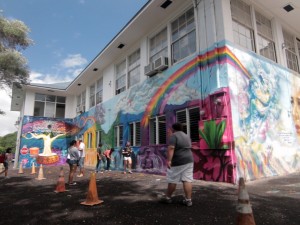Kamakau and Turtle Bay Resort team up to host a unique Makahiki celebration to educate both the Hawaiian community and the visiting tourists.
[spb_tabs width=”1/1″ el_position=”first last”] [spb_tab title=”ʻŌlelo Hawaiʻi”]Ceremony closed this Makahiki season and Faculty and students of S. M. Kamakau had a lot to smile about with the great turnout for the Kuilima event this weekend.
“Although this is a time of tranquility, it is also a time for us to continue to strive,” says Kamehaʻililani Waiau, Administrator Assistant at S. M. Kamakau.
Aside from ulu maika, moa pāheʻe and ʻōʻō ihe, she says there was an even greater victory.
“It’s important that we host this Makahiki celebration so that we can set an example for our communities about our Hawaiian traditions.”
Although the heʻe hōlua and Hawaiian style surfing isn’t usually a normal part of modern-day celebration, they were re-introduced by the Kamakau ʻohana.
“When we talk about having the Makahiki, you know, we really can’t say it’s in its entirety until we’ve put back every component that we celebrate, that our kūpuna celebrated,” says Pōhaku Stone, Coordinator for Kanalu.
And Kamehaʻililani couldn’t agree more. “If we can help the community to see that these are indeed living traditions, then that seed we intended to grow has flourished.”
Yet the goal wasn’t to just reach the Hawaiian community, Kamakau teamed up with Turtle Bay Resort to also try to educate tourists.
“I believed we’ve embarked on a journey that’s going to reinstitute who we are as native peoples here permanately in the way we invision it, not the way that tourism agencies invision it,” says Pōhaku.
“It helps to broaden the tourists’ perception of Hawaiʻi because it isn’t what they see in Waikīkī, it’s what they see in the countryside,” says Kamehaʻililani.
However, according to Kamehaʻililani, this is just one instance of reinvigorating our Hawaiian culture.
“We need to all think how we can contribute to our overall success because every effort means a win for the Hawaiian people.”
[/spb_tab] [spb_tab title=”English”]Ma ka pani kūpono ʻana o kēia wā makahiki, ua nui ko ka ʻohana Samuel Manaiakalani Kamakau mea e mahalo ai ma hope o ka holo kūpono ʻana o kā lākou hanana Makahiki Kūilima i mālama ʻia i kēia hopena pule i hala aku nei.
“I loko nō o kēia wā o ka maluhia o ka wā makahiki, he wā kēia he koʻikoʻi i loko o ka pono e hoʻomākaukau mau, hoʻokāʻoi mau a pēlā aku,” wahi a Kamehaʻililani Waiau, ka hope kahu no S. M. Kamakau.
A wahi āna, i waena o ka ulu maika, ka moa pāheʻe a me ka ʻōʻō ihe i ʻike ʻia kekahi lanakila o ia kula nei ʻo Kamakau, e pā ana i ka lāhui Hawaiʻi holoʻokoʻa.
“He mea koʻikoʻi ka mālama ʻana i ia mea o ia hoʻolauleʻa ʻo ka Makahiki e mākou, ke kula ʻo Kamakau i hiki ke laʻana maikaʻi no ko mākou mau ʻohana a me ke kaiāulu nō hoʻi, ka hana maʻamau o ka poʻe kupuna.”
ʻOiai ʻaʻole ʻo ka heʻe hōlua a me ka heʻe nalu kuʻuna kekahi hāʻuki maʻamau i mālama ʻia ma nā hoʻolauleʻa Makahiki o kēia ao, ua helu ʻia nō ua mau mea i loko o ko Kamakau hoʻolauleʻa ʻana.
ʻ”Aʻole i mālama kūpono ʻia ka Makahiki inā ʻaʻole hoʻolauleʻa ʻia nā hana a pau o ko kākou mau kūpuna,” wahi a Pōhaku Stone, ka luna hoʻi o ka hui ʻo Kanalu.
A ua kākoʻo piha ʻia kēia manaʻo e Kamehaʻililani. “Inā hiki ke kōkua aku i nā ʻohana e ʻike i ia mea he mea ola, he mea kuʻuna a he mea ola kēia wā, ma laila ko mākou ʻiʻini e kanu ai i kēlā ʻike, e kanu i ia hoihoi a me ia ʻiʻini e hoʻōla mau.”
A ʻaʻole o ke kaiāulu Hawaiʻi wale nō ka mea i pā ʻia. Ua hui aku ko Kamakau me ka hōkele ʻo Turtle Bay i mea e hoʻolaha aku i kēia ola o ka lāhui a moʻomeheu Hawaiʻi i nā malihini kekahi.
“Ua komo mākou i kekahi huakaʻi no ka pono o ko kākou aʻoaʻo kūpono ʻana i ka lehulehu no ko kākou Hawaiʻi ʻana,” wahi a Pōhaku.
“He kōkua kēia ʻano mālama i ka hoʻākea i ko lākou, ko ka malihini maopopo a ko ka malihini ʻike i ia mea he Hawaiʻi. ʻEā, ʻaʻole nā mea ma Waikīkī wale nō akā hiki nō ke mālama ʻia kēia ʻano ma ke kuaʻāina nei,” wahi a Kamehaʻililani.
A wahi āna, he hoʻokahi wale nō kēia o ka hāpai ʻana o ko kākou lāhui Hawaiʻi i luna.
“E ʻimi kākou a pau e noʻonʻo pehea ana e hoʻihoʻi a kaʻana aku i kou mau kalena a me kou aloha me ke kaiāulu i hiki ke hoʻoikaika ʻia kākou a pau. No laila, ka lanakila o kekahi kula a me kekahi hui kaiāulu, he lanakila kēlā no ka lāhui.”
[/spb_tab] [/spb_tabs]



